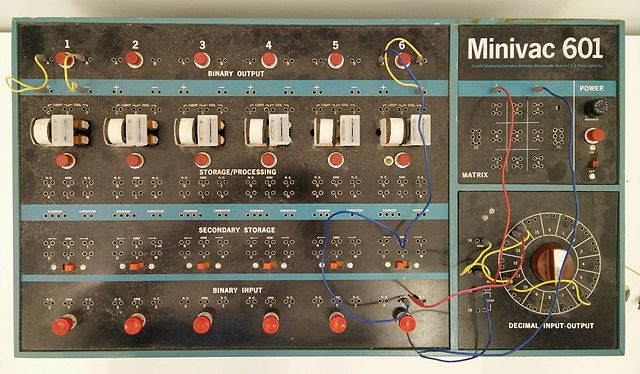
A master’s thesis is not typically a work of entirely original research or scholarship, like a PhD dissertation. Instead, it’s supposed to demonstrate, well, “mastery” of a field. But every once in a while, a student writes a master’s thesis that’s original and even groundbreaking. That’s what Claude Shannon did, back in the late 1930s.
Shannon was born April 30, 1916 in Michigan, in the US. He was a bright kid who liked building model airplanes and boats. With a friend he built a telegraph system that sent signals over the barbed wire in a fence that happened to pass between their two houses. He liked telegraphy, and got a job as a Western Union messenger — probably delivering telegrams by bicycle. His hero was Thomas Edison, and it was probably a pretty happy event when he found out they were related, although distantly.
He earned two BA degrees from the University of Michigan, in electrical engineering and math. His next stop was MIT for graduate studies, and that’s where he wrote that thesis, A Symbolic Analysis of Relay and Switching Circuits. It’s been called “possibly the most important, and also the most famous, master’s thesis of the century,” and “surely … one of the most important master’s theses ever written … It helped to change digital circuit design from an art to a science.” What Shannon had done was use Boolean math to establish a theoretical basis for digital circuitry. Before his work, digital circuit design was evidently partly guesswork.
Shannon was just getting started. During WWII he worked in cryptography, and wrote a paper, Communication Theory of Secrecy Systems, that’s considered the basis of modern cryptography. He then followed that up with A Mathematical Theory of Communication, which has been called the “Magna Carta of the Information Age.” It, too, was regarded as groundbreaking and “laid the foundations for the field of information theory.”
As if that wasn’t enough, Shannon built a sort of computer he called Theseus. It was the first electronic device that was capable of learning. It’s considered the world’s first example of AI, although it was built before the label was coined. These are only a tiny sample of his achievements, which have been described as equally as important as the work of Albert Einstein and Isaac Newton. And he was a pretty good mentor, too — Ivan Sutherland is a computer scientist regarded as the “father of computer graphics,” and he was one of Shannon’s graduate students. So was Danny Hillis, who pioneered parallel processing systems, not to mention spending several years as the Chief Imagineer at the Walt Disney company and designing toys for the Milton Bradley company.
Shannon may have instilled, or at least nurtured, that love of play in his graduate students. He was an amateur juggler, rode a unicycle, and built fanciful (but working) machines that calculated in Roman numerals, solved the Rubik’s Cube puzzle, and a wearable computer that supposedly improved your chances of winning at roulette.
Shannon lived to be 84, and spent most of his career at MIT and Bell Labs. There are six different statues of him, located at various universities and labs, and there’s a unit of information called the “shannon.” He won practically every prize and honor you can think of, but not a Nobel — probably because they don’t have a category (yet) for the various fields his work created. But if you use anything with digital circuitry, you can trace it directly back to Claude Shannon.
Illustration is the Minivan 601, a teaching computer designed by Claude Shannon around 1961. It was available as a kit. Photo by Autopilot – Own work, CC BY-SA 4.0, https://commons.wikimedia.org/w/index.php?curid=40164474
